Anchor Text SEO Best Practices for 2025
Oct 02, 2024
Written by Casey Bjorkdahl
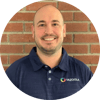
Casey Bjorkdahl is one of the pioneering thought leaders in the SEO community. In 2010, Casey co-founded Vazoola after working for a Digital Marketing Agency for five years in New York City. Vazoola is now one of the fastest growing and most widely recognized SEO marketing firms in the country.
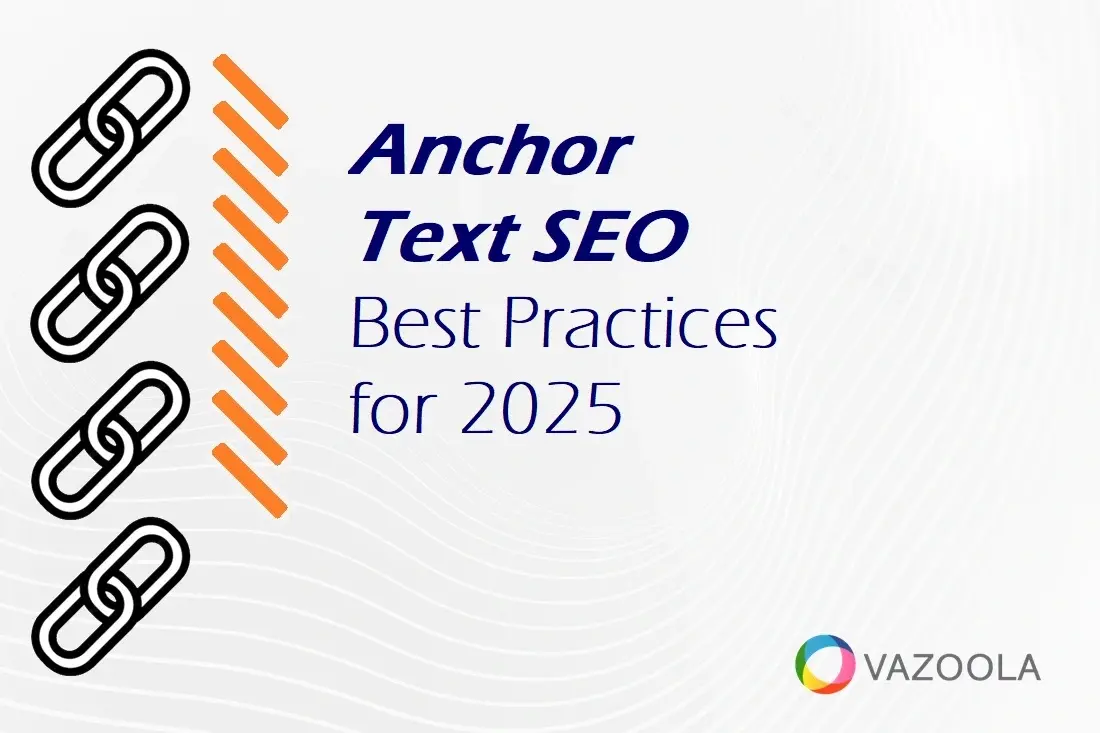
Casey Bjorkdahl is one of the pioneering thought leaders in the SEO community. In 2010, Casey co-founded Vazoola after working for a Digital Marketing Agency for five years in New York City. Vazoola is now one of the fastest growing and most widely recognized SEO marketing firms in the country.
If your goal is optimizing your website’s performance with search engines, you’ve first got to understand the role of anchor text.
Whether you're managing internal or external links, choosing the right anchor text impacts how search engines perceive your content.
The good news is there is advice and best practices to help you leverage anchor text for better SEO outcomes.
We’ve pulled from our own vast experience with link building to provide this guide to anchor text optimization.
Key Takeaways
-
Anchor text is the clickable part of a hyperlink. It helps search engines understand the linked page's content and relevance.
-
Effective anchor text should be descriptive, relevant, and natural to improve user experience and search engine rankings.
-
Over-optimized anchor text, particularly with exact match keywords, can result in search engine penalties.
-
Internal links with well-chosen anchor text help structure your website and improve the chances of ranking for targeted keywords.
-
A variety of anchor text types, including branded, partial match, and generic, creates a more natural backlink profile.
-
Tools like Ahrefs, SEMrush, and Moz Link Explorer help analyze and optimize your anchor text strategy.
Table of Contents
What Is Anchor Text in SEO?
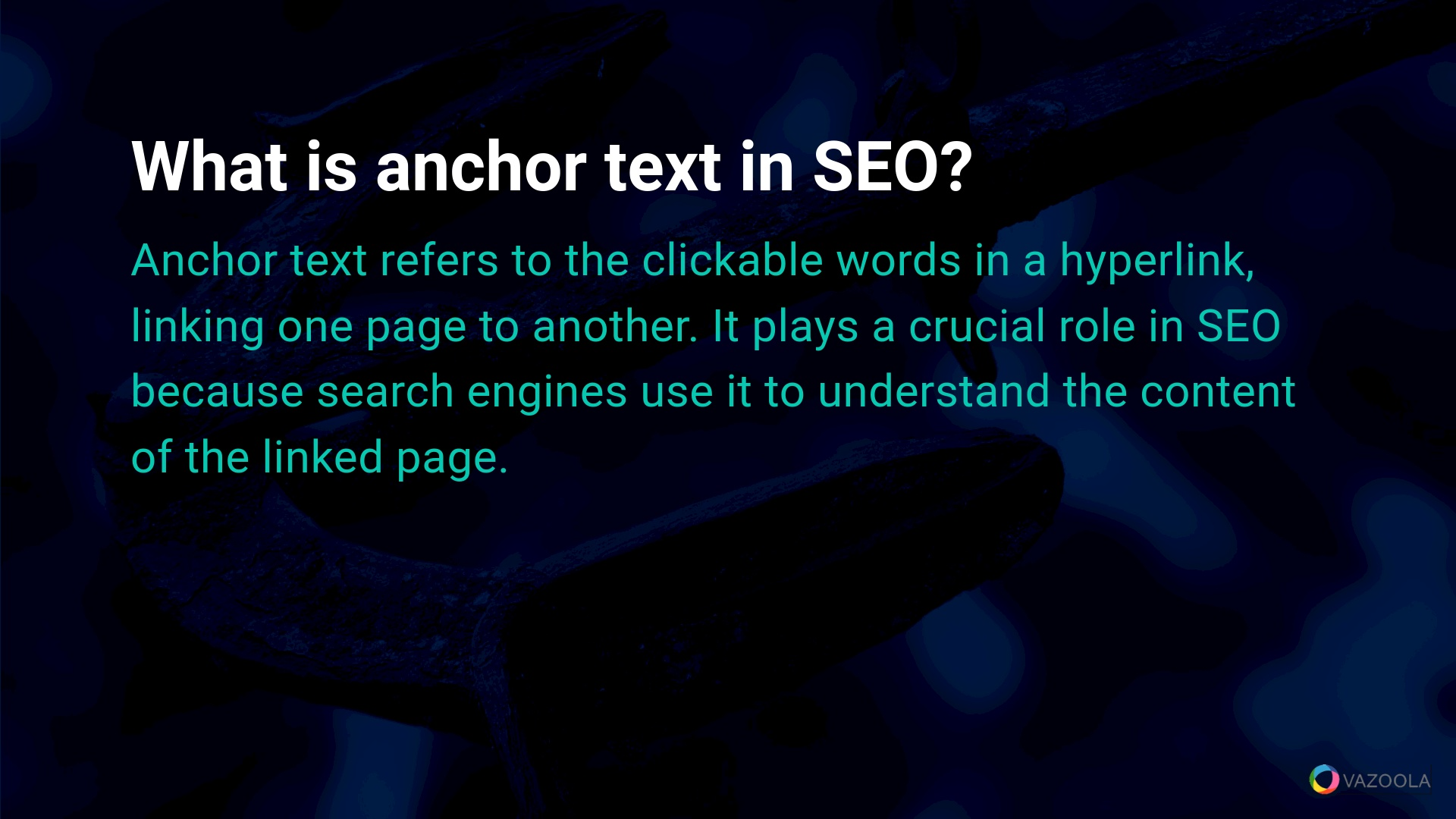
Do you know the anchor text definition? What does anchor text mean? Also, what is link text? Are they the same thing? We’ve got the answers.
Anchor texts, sometimes referred to as link text, are the clickable words in hyperlinks, linking one page to another. They play an important role in SEO because search engines use anchor text to understand the content of the linked page.
For example, when a link uses specific keywords as anchor text, search engines see a sign that the linked page is relevant to the keywords.
Effective anchor text boosts a site's ranking by signaling content relevance and authority. However, if it appears manipulative, over-optimization can lead to penalties from Google and other search engines.
The choice of anchor text, therefore, is of utmost importance. It influences both user experience and search engine perception, directly impacting SEO.
SEO Anchor Text for Internal Links
The anchor text of internal links helps search engines understand the structure and relevance of your website’s content.
When you use descriptive anchor text for internal links, search engines receive clear signals about the topic of the linked page. That improves the chances of ranking for related keywords.
For example, instead of using vague phrases like, "click here," we recommend you opt for specific keywords that reflect the content of the page you're linking to.
SEO Anchor Text for External Links
The anchor text for external links is the clickable words directing users from your site to another website.
External anchor text is important because it tells search engines what the linked page is about. That signal impacts the perceived relevance and authority of both the source and destination pages.
Our experience has taught us that relevant, context-rich anchor text for external links can boost your site’s credibility and improve the SEO of both linked and linking pages.
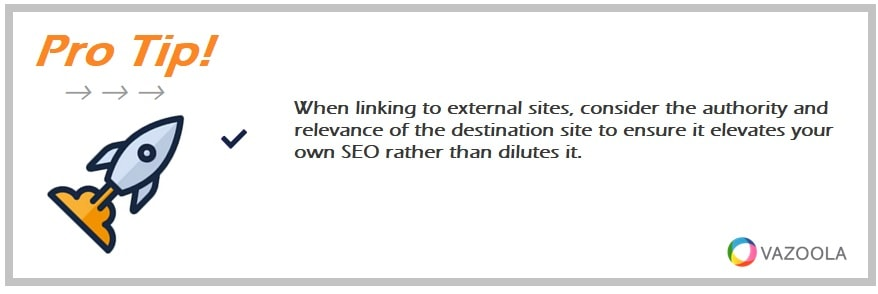
When linking to external sites, consider the authority and relevance of the destination site to ensure it elevates your own SEO rather than dilutes it.
Anchor Text Examples
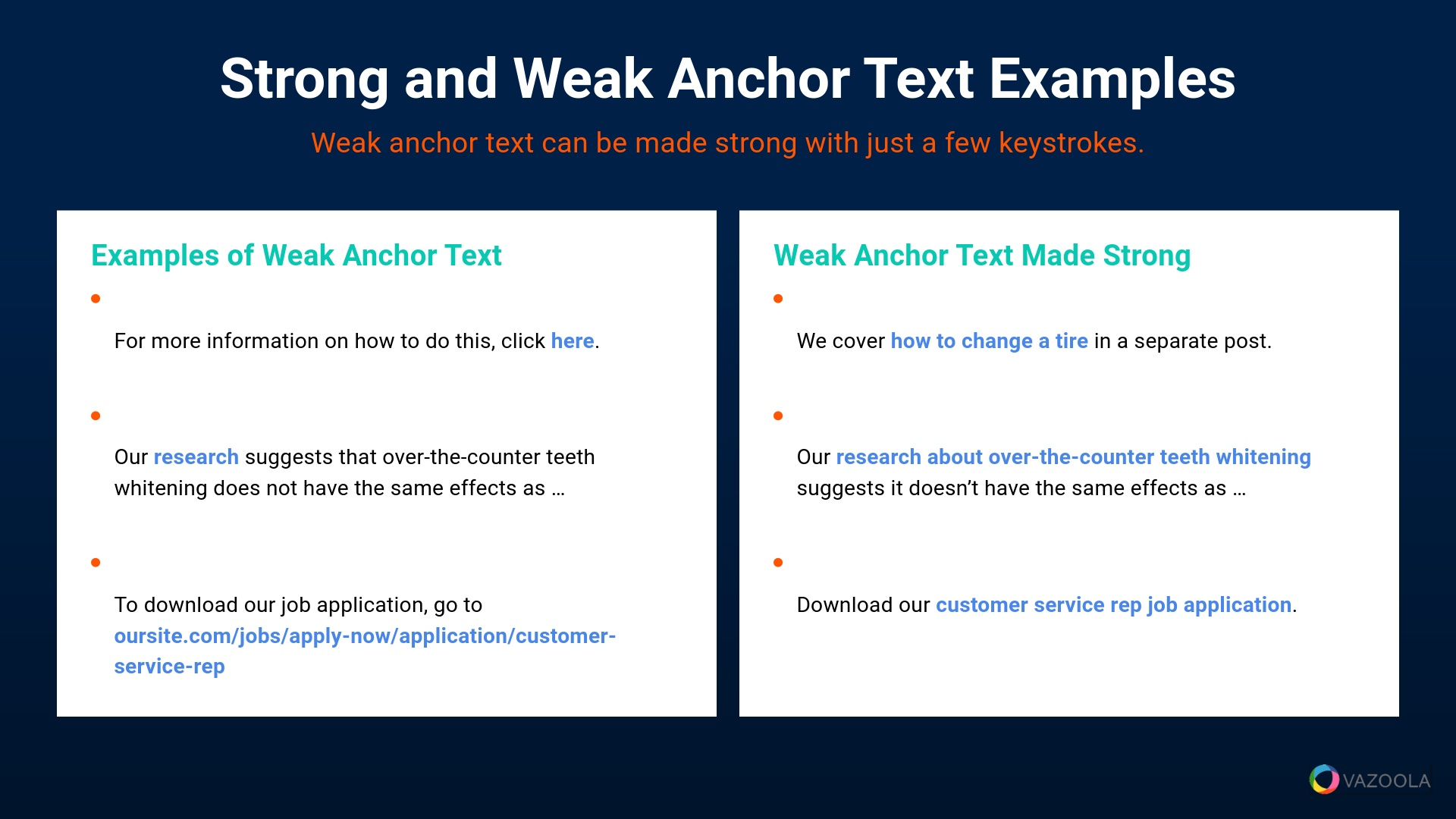
Google and other search engines read this text and evaluate the relevance of the target. Sites with more relevant anchor text will have a better chance of being found in search and should rank higher.
What Are The Types of Anchor Text?
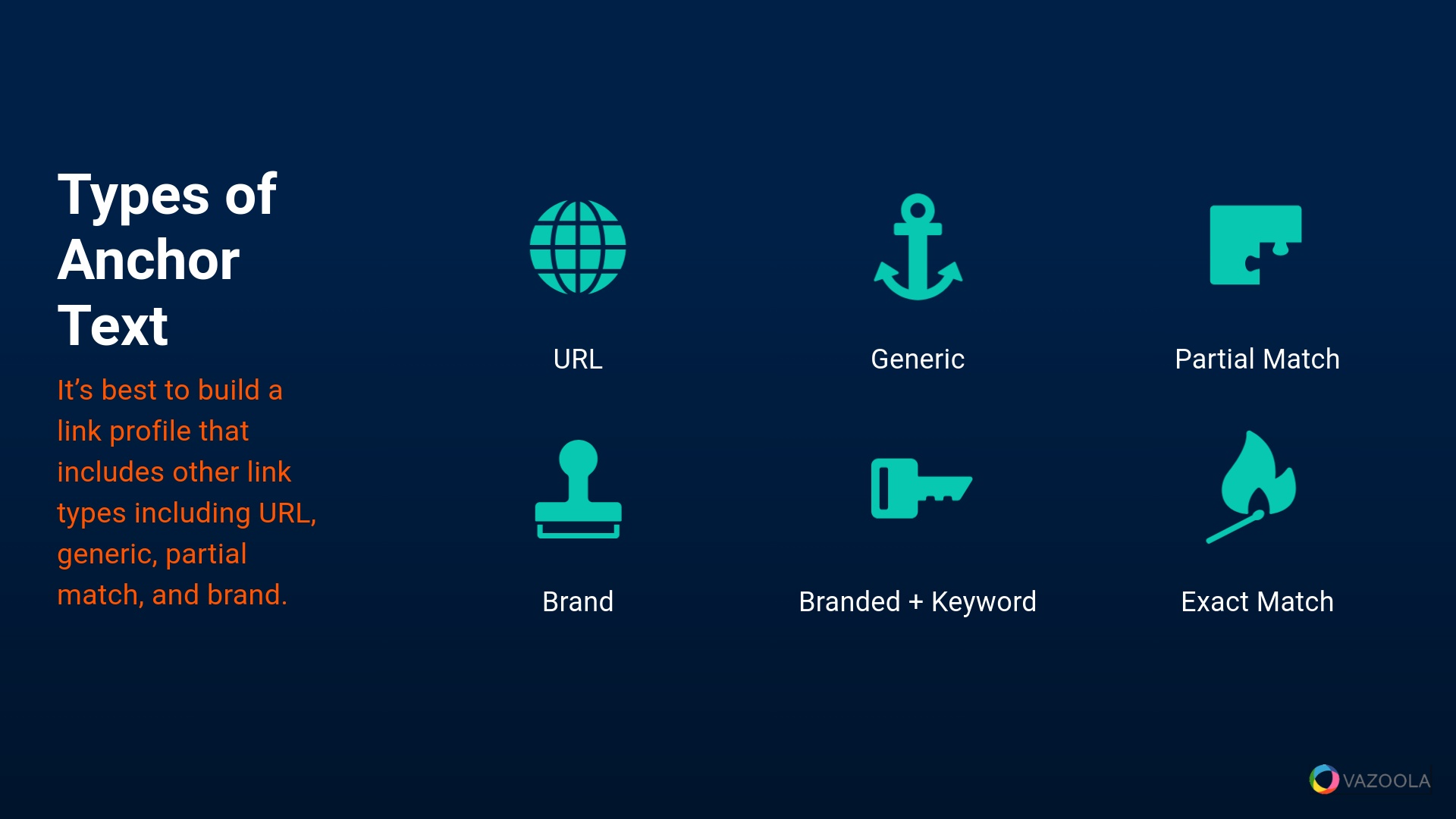
We’ve found it’s best to build a link profile featuring multiple link types of anchor text including URL, generic, partial match anchor text, and brand.
-
URL: Also called naked links, these are the exact URL where you want to send traffic.
-
Generic: Links such as “see it here,” “this content,” and “find this,” are anchor text examples of generic links.
-
Partial match: These links either contain additional words alongside your anchor text phrase or only some of the keywords.
-
Brand: These links include the brand or business name as part of the anchor text.
-
Branded + keyword: Just as its name suggests, this anchor text includes a brand’s name alongside a targeted keyword.
-
Exact-match: These keywords match the content of the page it’s linking to.
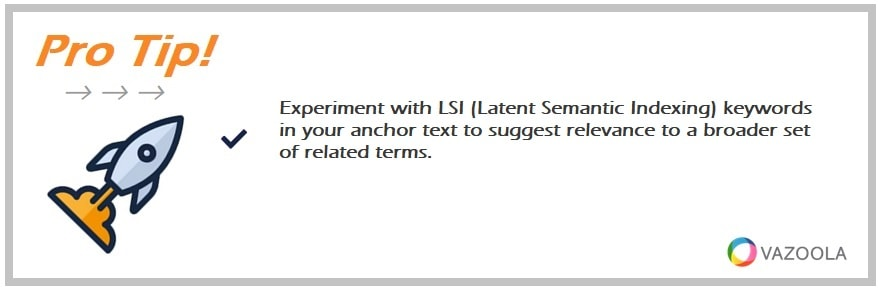
Experiment with LSI (Latent Semantic Indexing) keywords in your anchor text to suggest relevance to a broader set of related terms.
Pros and Cons of Exact Match Anchor Text
What is exact match anchor text?
Exact match anchor text includes a specific targeted keyword phrase as the clickable link. For example, if your keyword is "influencer marketing," the words "influencer marketing" would be your keyword anchor text.
In our experience, the approach can be highly effective because it tells search engines the linked content is relevant to the keyword. That way, you potentially improve your rankings.
However, there are risks associated with overusing exact match anchor text.
If used excessively, it can appear manipulative, which can result in penalties from search engines. Remember, search engines favor a natural and diverse backlink profile.
To avoid these risks, you should vary your anchor text, blending exact matches with other types, such as partial match, branded, or generic text.
A mixed bag of anchor text helps maintain a balanced and organic-looking backlink profile. This reduces the risk of penalties but still benefits from the targeted use of keywords.
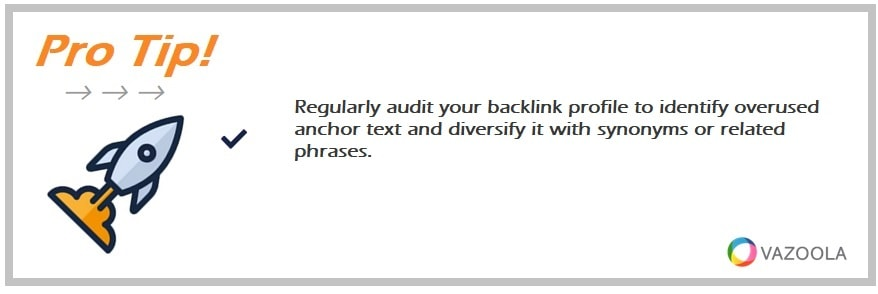
Regularly audit your backlink profile to identify overused anchor text and diversify it with synonyms or related phrases.
Anchor Text Best Practices
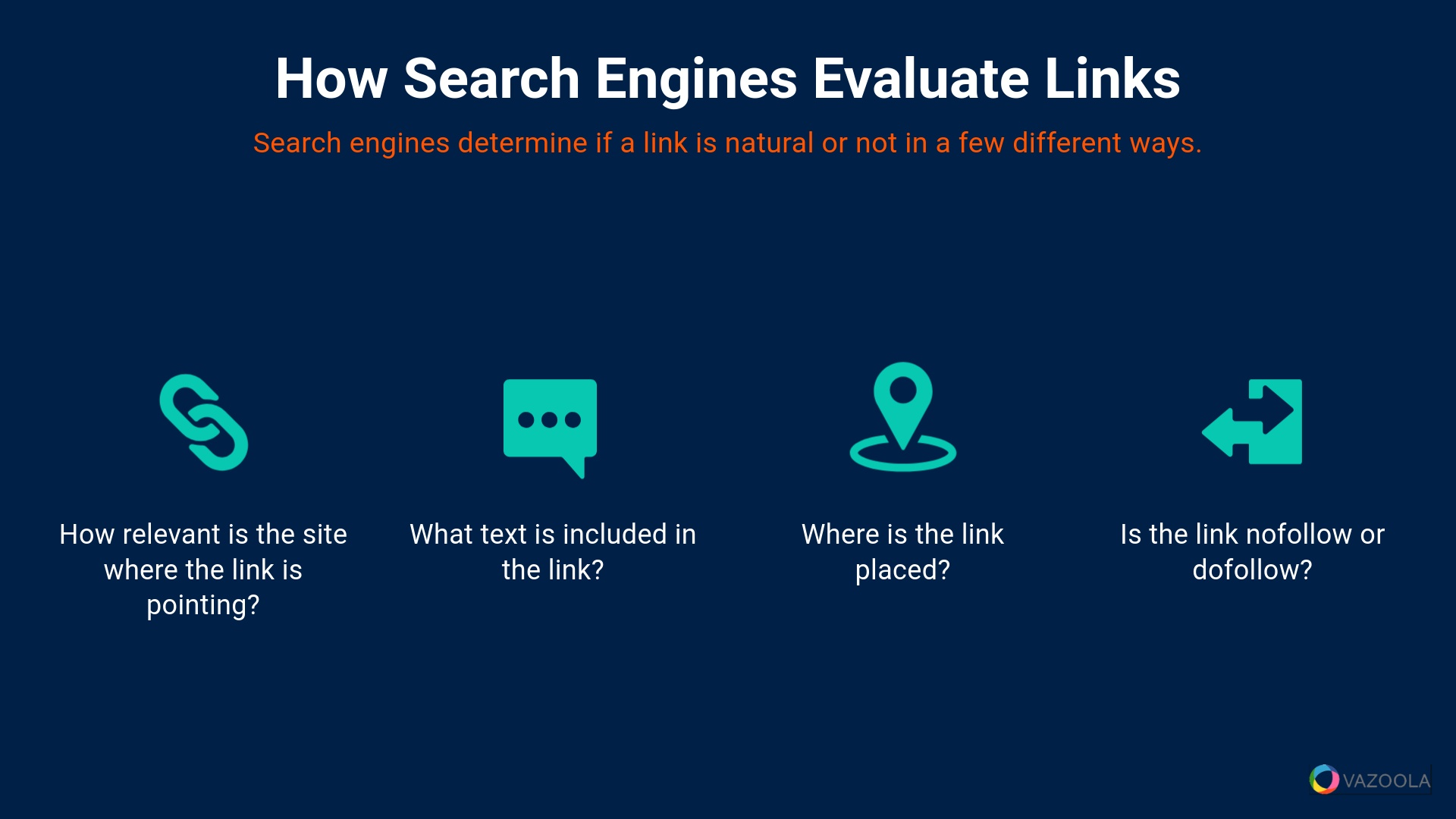
We’re here to tell you that building links is the best way to improve SEO. However, search engines don’t want and will punish anyone trying to manipulate search engine rankings.
Some of the ways search engines determine if link anchor text is natural or not include:
-
How relevant is the site where the link is pointing?
-
What text is included in the link?
-
Where is the link placed?
-
Is the link dofollow or nofollow?
Fortunately, you can implement some best practices that will maximize your success with anchor text.
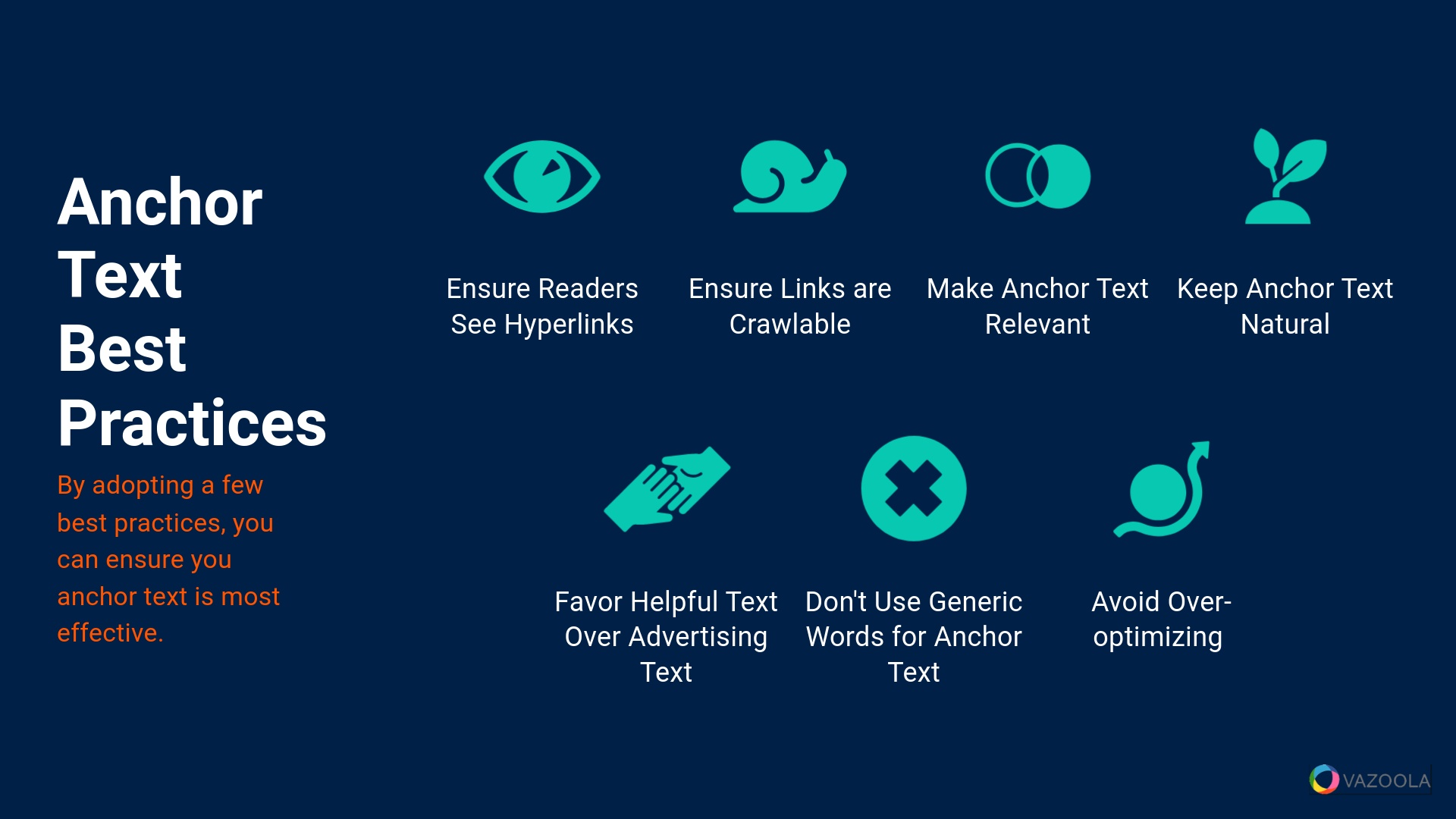
Make sure readers can see hyperlinks
When you create anchor text, you need to make sure your hyperlinks are easily visible to readers. Hard-to-see anchor text – like links that blend in with the surrounding text because of a similar color or lack of underlining – can be easily overlooked. That diminishes their efficacy.
Obvious anchor text, on the other hand, stands out and invites users to click. These anchor texts improve user experience and engagement.
To make sure your anchor text is noticeable, use a distinct color that contrasts with the regular text and consider underlining the link.
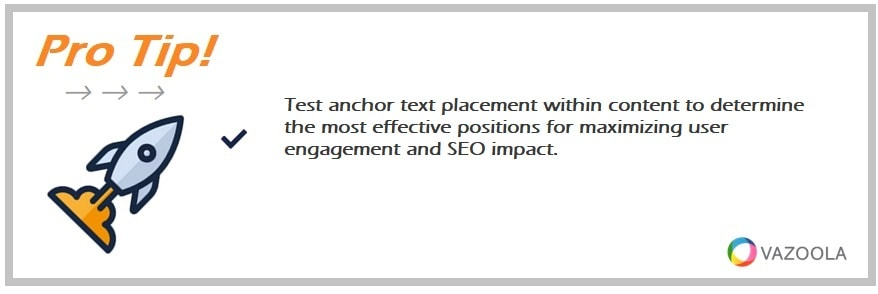
Test anchor text placement within content to determine the most effective positions for maximizing user engagement and SEO impact.
Make sure links are crawlable
If you want to make sure anchor text contributes to your site's SEO, your links must be crawlable by search engines. For search engines to follow it, a link must be properly formatted in HTML as an <a> tag with an “href” attribute.
Avoid using JavaScript, Flash, or other technologies that might obscure the link. These can prevent search engines from crawling the link and recognizing its value.
If a link isn’t crawlable, it won't be indexed, rendering it useless for SEO purposes.
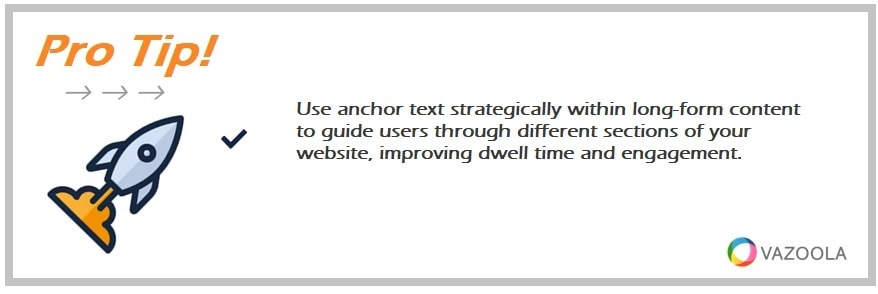
Use anchor text strategically within long-form content to guide users through different sections of your website, improving dwell time and engagement.
Make anchor text relevant
When building your link profile, do it from the perspective of a search engine. Gone are the days when using only exact match keywords boosted your rankings in search.
It’s increasingly just the opposite. In fact, overuse of exact match anchor text is viewed as manipulation. Back when Google's Penguin update rolled out in 2012, sites with excessive exact match links dropped in the rankings.
One of the primary reasons for the update was so Google could identify sites buying links or obtaining them through link networks.
Negative link-building tactics, also referred to as black hat, should always be avoided. Instead, webmasters should spend more time building authoritative, natural, and relevant links.
Further, website owners generally try to avoid hurting their search engine rankings, right? That means they should avoid using only exact match anchor text. Otherwise, they quickly could be facing penalties from Google.
Keep anchor text natural
When you think about useful articles you’ve read, how do their links appear? You can probably tell when you’re reading something written for bots rather than humans. Exact match anchor text often looks unnatural in the context of the page where they occur.
When you try to force a specific exact match anchor text on a page, the reader and the search engines will notice the forced anchor text format. Try reading it out loud. If it doesn't sound natural, it isn't. Don't use it.
Partial match links are a good way to link to another website naturally. Generic links are also very natural and safe to use.
Favor helpful text over advertising text
If you use too many exact match anchor text links your readers will consider them spam or outright advertising.
If you want to stuff your exact match anchor text with keywords that aren't relevant to the content on your page or the linked content, you certainly can do so. Just remember you aren't fooling anyone, including Google.
When building your link profile, be sure you minimize the amount of exact match anchor text to avoid triggering a penalty.
Be sure to use a variety of links. Make sure they are relevant. Then focus on links that appear natural. Choose sites with audiences that are your target customers.
Don’t use generic words for anchor text
Generic anchor text like, "click here," or "read more," should be avoided. They provide no context about the linked content.
Such vague phrases fail to give search engines or users any meaningful information about what to expect when they click the anchor text link. Instead, opt for descriptive, keyword-rich anchor text that clearly indicates the linked page’s content.
For example, instead of, "click here," use "learn about influencer marketing strategies," or "explore our SEO guide."
Avoid over-optimized anchor text
Anchor text over-optimization occurs when you use your targeted keywords too frequently in your anchor text links. It can appear manipulative to search engines.
The practice can actually lead to penalties – like a drop in rankings or even being de-indexed – since search engines prioritize natural, diverse link profiles.
To identify if you’ve done too much anchor text optimization, review your backlink profile to see if the same keywords are repeatedly used as anchor text. If so, you can fix it by diversifying your anchor text with variations, branded terms, and generic phrases.

Use anchor text variations that include action-oriented phrases. These encourage users to click while maintaining relevance to the linked content.
Tools to Optimize Anchor Text
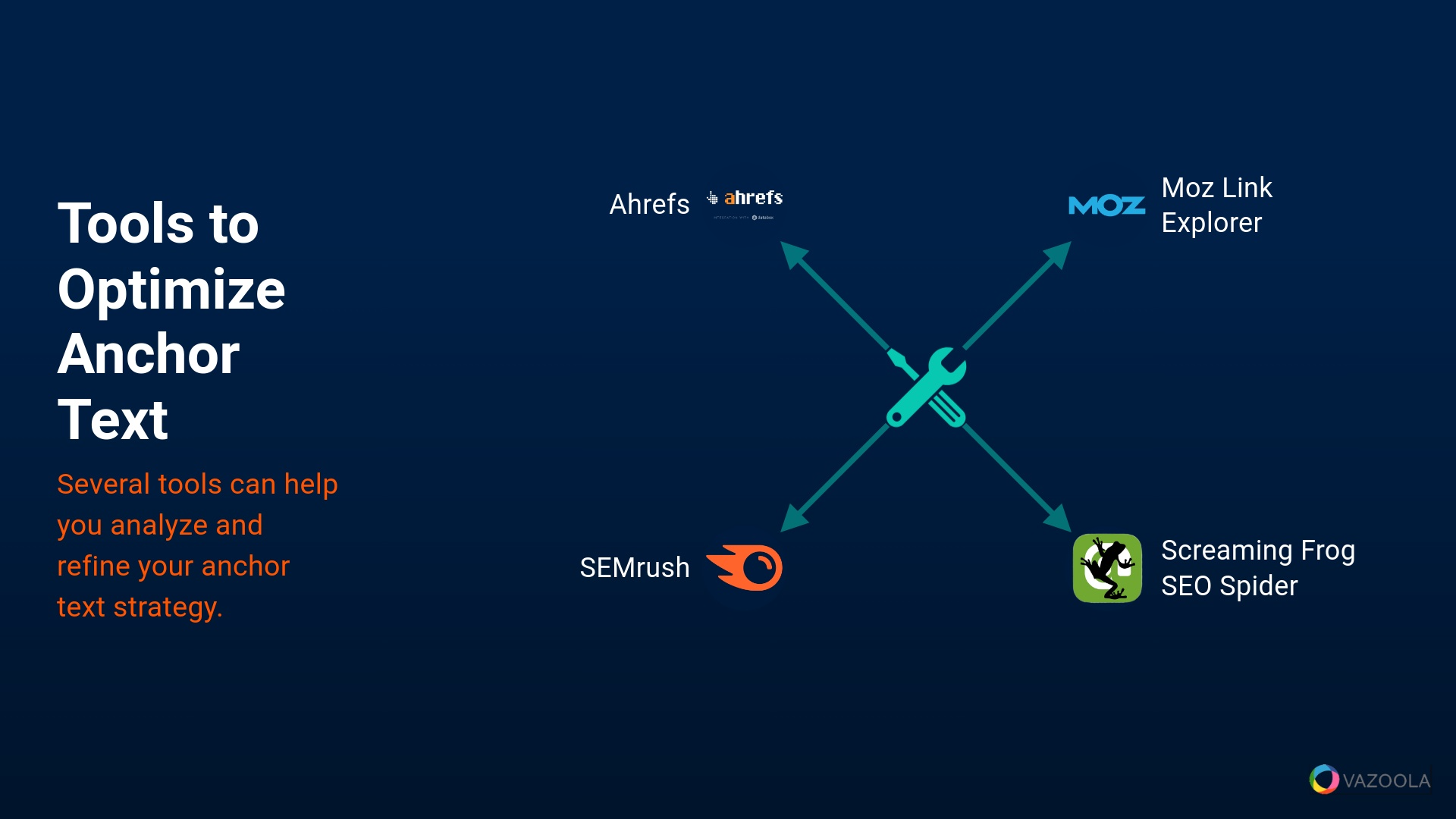
Now that you can define anchor text, it’s time to take it to the next level.
Optimizing anchor text is essential for maintaining a healthy backlink profile and avoiding penalties. We recommend a few different anchor text checker tool options that can help you analyze and refine your link building strategy.
Ahrefs
Ahrefs is a premium tool best known for its robust backlink analysis capabilities. It allows you to check the anchor text distribution across your backlinks. That process helps you identify potential over-optimization issues. The main con is its cost, which can be high for small businesses. Still, the depth of data makes it a worthwhile investment for serious SEO efforts.
SEMrush
SEMrush offers a comprehensive anchor text analysis as part of its broader SEO toolkit. It's great for identifying toxic links and spotting patterns in anchor text use. SEMrush is a premium tool, but it provides a wealth of insights beyond just anchor text. It’s thus valuable for holistic SEO management. The downside is its learning curve, which can be steep for beginners.
Moz Link Explorer
Moz Link Explorer is another popular tool that provides detailed reports on anchor text used in your backlinks. It’s particularly useful for smaller businesses because it offers a free version with limited capabilities. The premium version, however, unlocks more advanced features. The primary con is the free version may not provide enough data for in-depth analysis.
Screaming Frog SEO Spider
Screaming Frog is a desktop-based tool that crawls your website and checks a variety of SEO elements – including anchor text. The tool is best known for its flexibility and the ability to customize crawls. The free version has limitations on how many pages it can crawl, but the premium version is affordable and provides extensive features. The main con is that it’s more technical, which might be challenging for non-technical users.
Anchor Profiler
Anchor Profiler is designed specifically for anchor text analysis. The free tool offers a clear breakdown of anchor text distribution. That way, it’s easier to spot over-optimization or gaps in your SEO strategy. One of the tool’s strengths is its user-friendly interface, which simplifies the analysis process even for beginners. However, the tool’s focus is narrow, so it lacks the broader SEO features found in more comprehensive platforms.
Unlock the Power of Anchor Text
Mastering anchor text in SEO is important to elevate your website's search engine visibility and to maintain a natural and diverse backlink profile.
By carefully selecting the right types of anchor text, avoiding over-optimization, and utilizing some of the best online seo tools, you can improve your site's ranking and avoid potential penalties.
To see these best practices in action and learn how to optimize your anchor text strategy, contact Vazoola for a free demo. We’ll help you navigate the complexities of SEO and achieve your digital marketing goals.
For more information on exact match anchor text percentages, download our Ultimate Link Building Guide.

Monitor competitors' anchor text strategies using tools like Ahrefs or SEMrush to discover effective practices you can adapt to your own SEO efforts.

